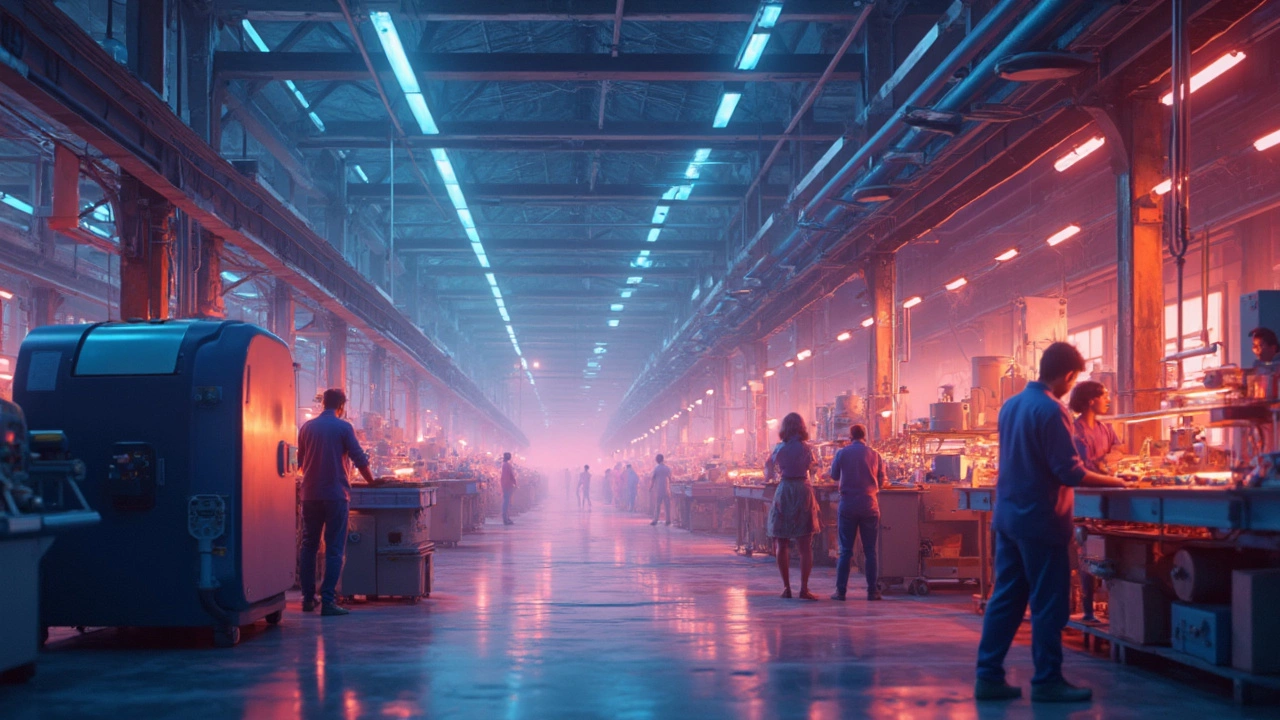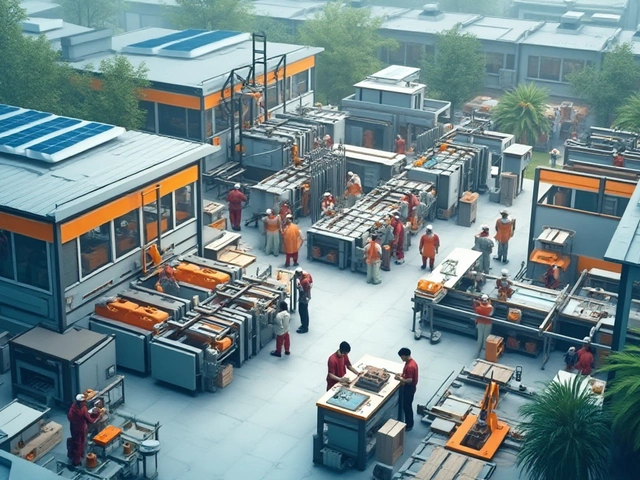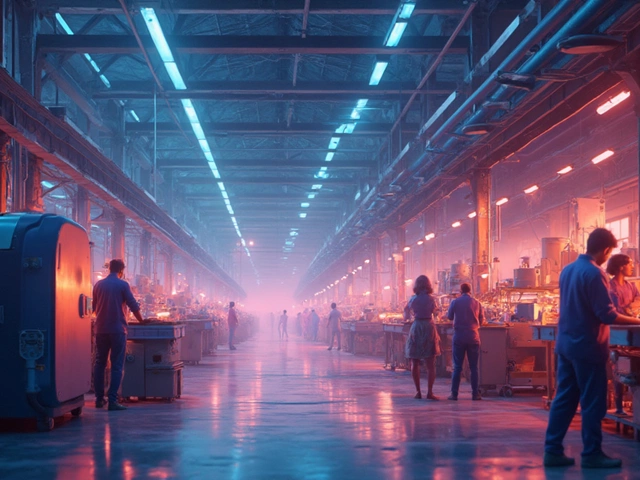So, you're pondering the manufacturing world and wondering where to set up shop? Well, here's a bit of news that'll have you nodding in interest: some business ideas are more promising than others. As of now, the manufacturing industry is buzzing with opportunities, with two clear winners leading the pack. Let's break it down a bit and see where the gold lies.
First up, 3D printing. You might think of it as just a machines spitting out plastic trinkets, but it's oh so much more. This tech is reshaping industries, creating everything from custom prosthetics to tools and components on demand. It's fast, efficient, and cutting down on traditional manufacturing costs in a big way. If jumping on a future-forward trend is your jam, then this should be on your radar.
- 3D Printing Revolution
- Eco-Friendly Manufacturing
- Automation in Production
- Customization and Niche Markets
3D Printing Revolution
Alright, folks, if you haven't heard by now, 3D printing is more than just a buzzword. This tech is pumping life into the manufacturing scene with some serious potential. Gone are the days when creating prototypes took months. With 3D printing, you can whip up parts and products almost as fast as you can think of them. Crazy, right?
Here’s how it works: you start with a digital design, and the printer lays down layers of material to build that item from the ground up. It's like something out of a sci-fi movie! From healthcare, where custom medical devices are revolutionizing patient care, to aerospace, where lightweight components are a game-changer, the applications seem limitless.
What's super cool is how this tech is all about cutting waste. Instead of chiseling away at larger blocks, it uses only what's needed. Less material used means more cost-effective production, and let's face it, who doesn't love saving some cash?
For those thinking about diving into this arena, a few tips:
- Understand your market. Whether you're diving into healthcare, consumer products, or architecture, know the ins and outs.
- Invest in quality software and hardware. A solid 3D printer and design software combo is your bread and butter.
- Keep up with the trends. This tech evolves fast, so stay in the loop with industry news and updates.
If numbers get you excited, check this out:
| Industry | Growth Rate % |
|---|---|
| 3D Printing Market | 23.5 |
| Healthcare Additive Manufacturing | 27.8 |
So, there you have it. 3D printing is transforming the manufacturing business landscape, leading the charge with innovation at its core. Dive in now, and you could be part of something revolutionary.
Eco-Friendly Manufacturing
Let’s dive into the world of eco-friendly manufacturing, where business meets sustainability. It's more than just a trend—it's becoming a must-do for companies looking to stay relevant and responsible. We're talking about practices that don't just help the planet but can also cut costs and open new markets.
Have you heard about solar-powered factories? These setups not only minimize carbon footprints but can significantly reduce energy bills. Picture this: you're harnessing the sun's power to run your operations, freeing up cash that'd otherwise go to the utility bills. Some businesses report energy savings of up to 30%, which is no small potatoes when you're balancing the books.
Another hot topic in the eco-friendly manufacturing space is using recycled materials. Brands are increasingly sourcing materials like recycled plastics or metals, reducing waste, and lowering raw material costs. Producing with the planet in mind not only attracts eco-conscious buyers but also boosts your brand's image.
Let's not forget water usage. Manufacturing can be a thirsty business, but incorporating water-saving technologies can make a huge difference. Things like closed-loop water systems can recycle water, slashing consumption by up to 75%. Imagine not just saving water but reducing the fees and taxes that go with it.
- Adopt energy-efficient technologies to minimize environmental impact.
- Use renewable energy sources to cut down on pollution.
- Implement waste reduction strategies like recycling and reusing.
- Consider sourcing locally to reduce shipping emissions.
Data supports these changes, showing eco-friendly businesses often see better growth rates. If you’re jumping into manufacturing and want to play the long game, embracing these sustainable practices could be your secret weapon. The demand for eco-friendly manufacturing solutions is only going to rise as more customers and companies become environmentally conscious. Being a leader in this field can set you apart in a very crowded marketplace.

Automation in Production
Picture this: machines whirring away, turning raw materials into finished products, almost like magic. That's automation in manufacturing for you, and it's revolutionizing how we make stuff. Gone are the days when production lines were filled with workers doing the same tedious tasks over and over. Now, robots and AI are stepping in, making processes faster and way more efficient.
Automation isn't just about speed, though. It's about precision, consistency, and cutting down on mistakes. When you have robots doing the heavy lifting, products are made with absolute accuracy, reducing waste and improving quality. If you're thinking of diving into the manufacturing business scene, embracing automation could seriously boost your efficiency.
One cool aspect of automation is how it opens the door to what they call 'smart factories.' Imagine a place where machines talk to each other, analyzing data and optimizing production without human intervention. This isn't science fiction—it's already happening around the globe. For instance, Siemens is using digital twins, a virtual model of products, to simulate and optimize production in real-time.
Considering the benefits of embracing automation, here’s a quick checklist on how to get started:
- Firstly, identify repetitive or hazardous tasks that could benefit from automation.
- Invest in training for your team to manage and maintain automated systems.
- Look into programmable logic controllers (PLCs) to control machinery and make smart decisions.
- Don't forget to integrate Internet of Things (IoT) devices for real-time data tracking and analysis.
- Set up robust cybersecurity defenses to protect your automated systems from digital threats.
A stat worth noting: according to a survey by PwC, 45% of work activities could be automated using current technology. That's nearly half the jobs in manufacturing! It's clear that automation isn't just a trend; it's the future. So whether you're dipping your toes into successful manufacturing or running a full-fledged operation, automation can be a game-changer.
Overall, automation is setting new standards in the manufacturing business. It allows you to meet demand with speed and precision while tackling the rising challenges of global competition and labor shortages. Jumping onto the automation train may just give your business the edge it needs to stay ahead.
Customization and Niche Markets
Alright, let's get into the good stuff when it comes to successful manufacturing. Imagine a world where your business caters to individual needs, customizing products and serving niche markets. This is not just a dream but a strong reality in today’s market.
Consumers are looking for that personalized touch more than ever. Whether it’s custom sneakers, tailored gadgets, or bespoke furniture, personalization is in. This trend is reshaping the way we think about products—it’s about making them uniquely yours. Many businesses see this as a golden opportunity to stand out in a crowded market.
Why is this such a big deal? Well, customized products allow for better price margins. Customers are often willing to pay a premium for something that fits them perfectly. Plus, it builds brand loyalty. If you've ever gifted someone a customized item, you know it leaves a lasting impression.
Starting a business in niche markets doesn't mean you have to go big right away. Actually, the beauty is in starting small. Here’s how you can slide into this sector:
- Research: Know your audience. What do they crave? What are competitors missing? Get that insight and you’re halfway there.
- Prototype: Start with a prototype. Test it, tweak it, and get feedback. It’s all about evolving the product to what the consumer really wants.
- Technology: Use reliable tech to automate customization. Software that allows customers to design their own products can be a game-changer.
- Marketing: Connect with your group. Build strong relationships through social media or personalized marketing strategies.
Going niche also means less competition and often higher loyalty. Here's a cool stat: 70% of consumers say they’re more likely to be loyal to a brand that offers customization (source: Econsultancy). So, tap into this trend, and your business can strike gold in a specialized market.






Write a comment